In the midst of US-Iran military escalation on the Iraqi scene which some regional countries had always warned of particularly its disastrous impact on security and stability, the IRGC targeted on Wednesday at dawn, January 8, 2020, two US bases. The first target was Ain al-Asad airbase in the province of Anbar in western Iraq. The second one was al-Harir airbase in Erbil. The two bases were hit by 10 medium-range ballistic missiles in response to the assassination of the IRGC’s Qods Force Commander, General Qassem Soleimani, who died in a US drone attack which targeted his convoy near Baghdad International Airport on Sunday, January 3, 2020. The missile strikes caused no deaths or injuries, according to the official narrative of the US administration.
These Iranian missile attacks on the US bases, which came following Iranian threats of military response, raise several questions: Is the Iranian decision to militarily respond and attack the US bases part of its plan to revenge the killing of Soleimani? Or did the attacks intend to end any scenarios for a possible war that would be devastating on all fronts? How shall we describe such missile attacks? Has Tehran realized, following the attacks, the strong US message of deterrence in response to the killing of Americans? What are the gains made by Iran after the escalation against US targets of which some regional countries have long warned? And what are the future scenarios of the US-Iran escalation?
I- The Scope and Nature of the Iranian Missile Strikes Against US Bases
Several experts on Iranian affairs described the Iranian missile attacks on the two US bases by 10 Fateh 313 ballistic missiles (see Table No.1) in Iraq only five days after the assassination of Soleimani as ‘symbolic and small-scale,’ given the speedy remarks made by Iranian officials, even before the US President Donald Trump had the opportunity to speak, about the ‘end of response and stopping the escalation.’ It is believed the missile attacks intended to save the face of the Iranian political system at home and abroad. The Iranian Foreign Minister Mohammad Javad Zarif published a post on Twitter that “Iran took & concluded proportionate measures in self-defense under Article 51 of UN Charter targeting base from which cowardly armed attack against our citizens & senior officials were launched.” He also added,” We do not seek escalation or war, but will defend ourselves against any aggression.”
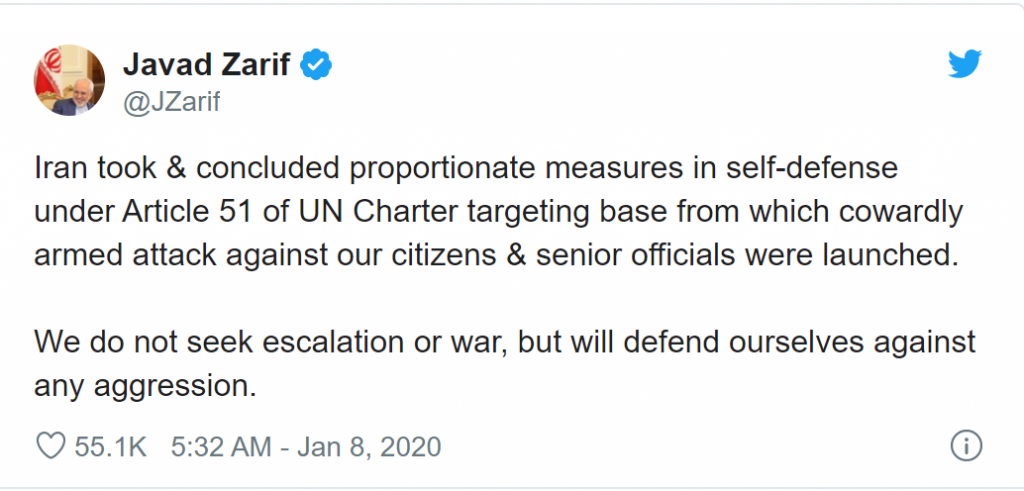
The Iranian armed forces’ Chief of Staff, Major General Hossein Bagheri, warned the US in a statement of the dire consequences of the US killing of Soleimani. The Spokesman for the Iranian government Ali Rabiei said in a Twitter post that “We don’t seek to start a war, but any other aggression from the US will be faced with a more painful response.”
Table 1: Features of the Iranian Ballistic Missile Fateh 313
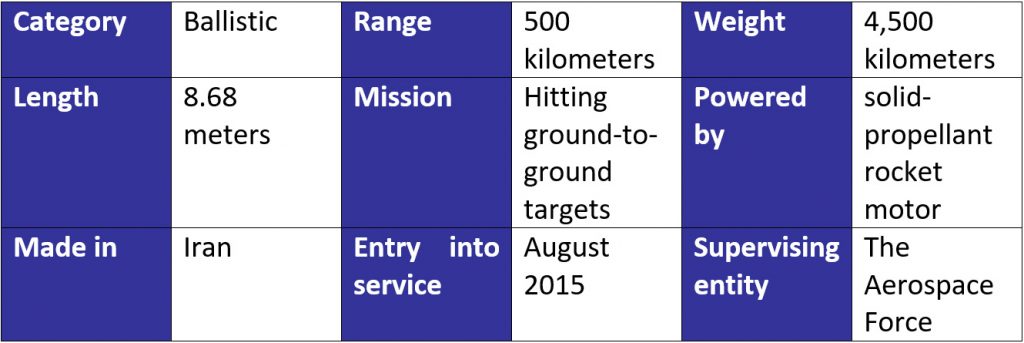

The US response following the Iranian missile attacks makes the possibility of a symbolic and limited-scale Iranian strike likelier. The US President Donald Trump, known for his swift and threatening responses, following the tweet of Zarif, wrote a Twitter post. He said, “ All is well!”.
President Trump, in the speech he gave from the main reception hall in the White House, not from the Oval Office – where historic proclamations of US wars and victories have been made – on the evening of the day of the Iranian missile attacks, resorted to reducing escalation against Iran after its symbolic and limited response. He said Washington seeks peace with those who want peace, hinting at tightening economic sanctions on Iran while considering other options (which he did not specify) in order to alter Iran’s regional behavior. He added, Iran could have a great future but must stop terror, reduce escalation and enter into a new nuclear agreement.
While threatening to impose new sanctions when he said “by killing Soleimani, we have sent a powerful message” that the US will impose a new package of economic sanctions on Iran until it is forced to reverse its policies […] ISIS is a natural enemy of Iran. The destruction of ISIS is good for Iran, and we should work together on this and other shared priorities […] The United States is ready to embrace peace with all who seek it.” Trump mentioned that his country has become the biggest producer of oil and gas in the world. “We have this great military and equipment, however, does not mean we have to use it. We do not want to use it. American strength, both military and economic, is the best deterrent.” He asserted that Iran got $150 billion after signing the nuclear deal, and, instead of thanking his country, Iranians were chanting “Death of America.” He said, “Iran went on a terror spree, funded by the money from the deal, and created hell in Yemen, Syria, Lebanon, Afghanistan and Iraq […] The regime also greatly tightened the reins on their own country, even recently killing 1,500 people at the many protests that are taking place all throughout Iran.” He also noted that he is “ going to ask NATO to become much more involved in the Middle East process,” in a very important indication of the priority and orientation of the US administration.
Another indication that the Iranian missile strikes were symbolic is that President Donald Trump asserted that not even a single American national was killed in the Iranian attacks on the two US bases although the Iranians claimed 80 US soldiers had lost their lives.
He said that the Iranian missile attacks caused no casualties among Iraqis or Americans due to the early warning system. This means that Tehran realized the red lines set by the US and understood the US deterrence messages not to target US soldiers. The US-Iranian conflict was sparked following the death of a US civil contractor and injuries to others, both Americans and Iraqis, in rocket attacks carried out by the pro-Iran Popular Mobilization Forces (PMF) in Iraq on the US-Iraq K-1 base in Kirkuk. The attacks contributed to creating a public opinion in the US against Iranian behavior, which could be exploited to make gains in the 2020 presidential elections.
II- Motivations behind Iranian Missile Strikes on US bases:
1- The Domestic Calculations of Iranian Ruling System
The leaders of the Iranian ruling system were fully aware of the enormity of the domestic consequences if it ruled out a military option against US targets even if the response was limited in scope A no-response option would lead to the support that the ruling system receives from its supporters and backers in Shiite incubators within the heart of the theocratic regime to dwindle. This will boosts the Conservatives while expanding the circle of the government’s dissidents as well as increase domestic pressures, represented in the form of protesters demanding revenge for Soleimani’s killing, with them raising the red banner “O Revenge for Hussein” over the dome of Jamkarān Mosque in the city of Qom. The red banner is raised, as it suggests the spilling of blood and will remain raised until Iran carries out revenge attacks. It also refers to the Iranians’ extreme anger about the death of Soleimani. The Iranian aim was clear when the US claimed responsibility for the death of Qassem Soleimani, Abu Mahdi al-Muhandis and their companions. All the above factors motivated Iran into carrying out revenge attacks in response to the killing of Soleimani.
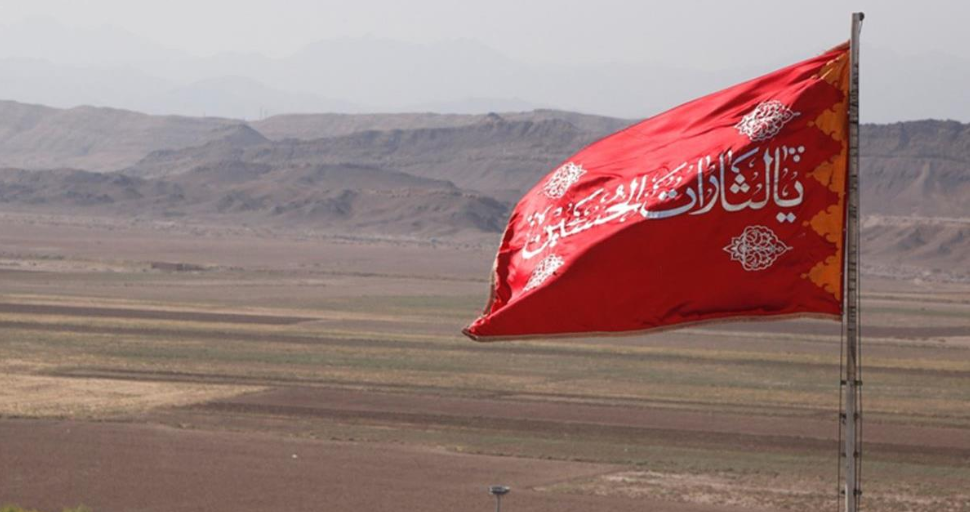
2- Carrying Out a Military Response to Boost Credibility
The leaders of the Iranian ruling system realized that if they refrained from carrying out a military response, this would impact their credibility. The main message embedded in the remarks made by Iranian officials regardless of their military, religious and political rankings to the killing of Qassem Soleimani was they will definitely respond and take revenge. The Iranian Supreme Leader Ali Khamenei announced on Sunday, January 3, 2020 a three-day nationwide mourning, vowing, as he visited the family of Soleimani on January 4, to revenge the killing of Qassem Soleimani when and where appropriate. The Iranian President Hassan Rouhani, meanwhile, vowed to, during a visit to Soleimani’s family, to carry out an act of harsh revenge for the killing of Soleimani, adding that everyone will seek revenge for Soleimani, in response to a question from his daughter about those who will get revenge for her father.
Also, the Supreme National Security Council, as the highest security apparatus in the country, revealed, after meetings held in the presence of Khamenei and Rouhani on Sunday, January 3, 2020, that it had taken the necessary decisions to respond to the US. This is consistent with the remarks of the Commander in Chief of the IRGC, Major General Hossein Salami, on Wednesday, January 6, when he said orders had been given for a response. He said:” I declare it plainly and in an unambiguous way. Orders have been given. We are getting a powerful, decisive, firm, regret-provoking and blowing revenge. The US has no place in the region”. This is in addition to the army’s Commander in Chief, Major General Abdel-Rahim Mousavi, saying that the assassination of Soleimani will never go unpunished.
For his part, the Iranian Foreign Minister Mohammad Javad Zarif described the US message telling Iran not to carry out a strong response to revenge the killing of Soleiman, delivered by the Swiss ambassador to Tehran, who is the head of the US interest section, as rude. A special aide to the speaker of the Iranian parliament Hossein Amir Abdullahian wrote in a post on Twitter that Soleimani is not the martyr of 80 million Iranians, but of 1.5 billion Muslims worldwide. Such remarks, along with the emotion expressed by leaders of the Iranian regime during the funeral prayers of Soleimani, as well as the shock on the faces of senior regime officials and the millions who partook in bidding farewell to Soleimani, reveal that the Iranian response was not surprising.
III- The Motives Behind Iran Choosing Iraq as the Arena for Its Military Response
Iraq has been a top priority for Iran due to it being the closest defense line to where the United States targeted the mastermind and architect of Iran’s regional project; Soliemani. This is in addition to the vulnerability of US interests and bases spread across Iraq (See Table No 2.) whether due to geographic proximity to Iran or the wide-ranging deployment of Iran-aligned armed militias across the country, which makes striking US targets within the realm of possibility. This is in addition to the importance of Iraq in the Iranian strategic mindset as a westward geographical extension for Iran, an arena for exercising influence, an economic artery and an outlet for reducing the pressures of economic sanctions. In addition, Iraq’s centrality to Iranian strategy, its strategic sectarian makeup, and its security and military importance for expanding Iranian influence westward (towards Arab countries), which in the end helps in creating the Iranian corridor to the Mediterranean. This is in addition to Iraq being a perfect channel for smuggling and transferring weapons to Hezbollah and other Iran-aligned militias in Syria and other parts in the region.
Table 2: US Military Bases
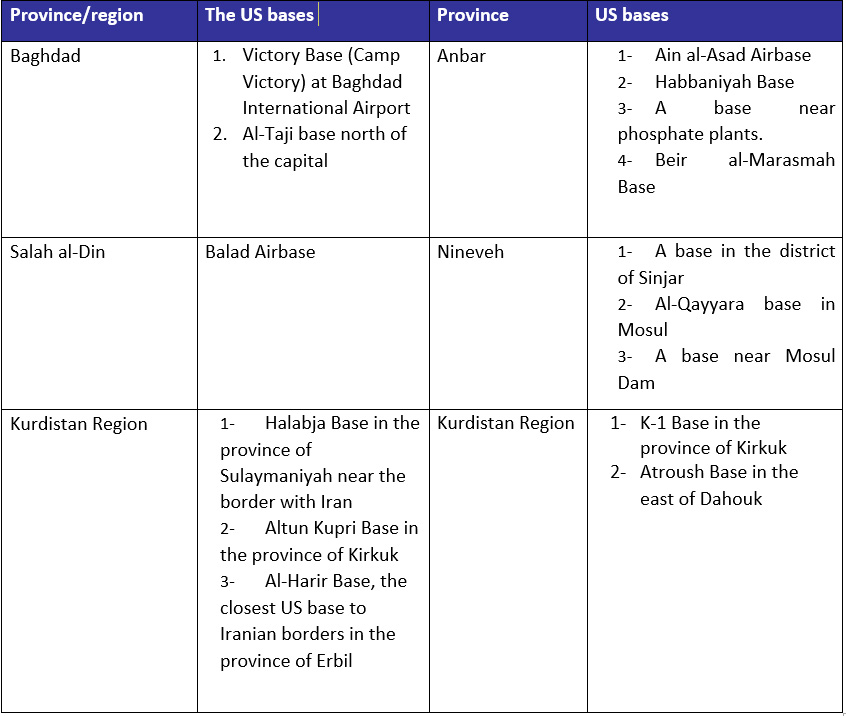
IV- Factors Influencing Iran’s Choosing of a ‘Small-Scale Response’ Scenario
1- The Nature of the Regime’s Elite and Priorities: the ruling elite in Iran is rational and well-aware of the huge gap between the capabilities of both the US and Iran. It fears engaging in misadventures which could impact the regime which has been ruling the country for the past 40 years as maintaining the ruling regime is the topmost priority of the leadership of the regime despite the killing of a military commander, even if this commander is as heavyweight such as Soleimani. The elite has given priority to the regime’s survival and longevity in order to implement Iranian schemes and projects at home and abroad. This has placed a curb on Iran’s approach in choosing any uncalculated measure which it fears would impact the strength and position of the ruling regime.
2- A Tit-for-tat: It seems that Iran assessed the US targeting of Soleimani as an escalation-for-escalation, not a shift in the US position towards curbing its regional clout. Therefore, it opted for a small-scale confrontation scenario, without killing or injuring US troops as it is aware of the US red lines. This is in addition to Iran’s own complicated calculations which could arise if it engaged in an all-out confrontation with the US, such as risking the survival of the regime and its expanding regional clout, which has resulted in Iran incurring huge human and material losses. Iran is waiting to reap the benefits of its regional clout in light of its dire economic conditions. This is in addition to the high price that Iran will pay in case of engaging in an open-ended confrontation with a major world power, with which it is not on par militarily or economically in any part of the world.
3- The Massive Military Capabilities of the United States: The Iranian leadership is well aware of US military capabilities in all the areas of contagion with Iran, which include dozens of US military airbases deployed around the borders of the Iranian state and the sweeping superiority of the US navy over the Iranian fleet, which makes several Iranian targets within the range of US fire. Also, Iranian oil platforms in the Gulf waters are an easy target for the US air force and the headquarters of the Shiite militias in Iraq stand uncovered in the face of US strikes. However, at the political level, Iran uses clever negotiating skills to maximize gains as Trump mentioned that “Iran never won a war, but never lost a negotiation.”
4- The Costly All-out Confrontation Scenario: This happens in light of the material and human costs required to engage in military confrontation which would catastrophic implications for all concerned parties in the region given that the Iranian economy is hit with economic sanctions and Iran’s prioritization of asymmetric warfare (fourth generation warfare) over conventional warfare (first generation warfare). This is in addition to Iran losing the support of European actors who could stand with it after defying the international community by announcing the fifth stage of reducing its nuclear obligations. Iran prefers to resort to limited confrontations so that it does not bear a direct cost based on past experiences.
V-Future Scenarios of the Iran-US Spat
In light of the foregoing, and the nature of the US-Iranian statements after the Iranian missile attacks on the US bases in Iraq and the positions of Iranian proxies in Iraq, Syria, Yemen, and Lebanon, the likeliest scenario revolves around stopping a direct US-Iranian escalation, with the two sides ceasing strikes on each other’s military targets.
Zarif swiftly announced that Iran has conducted an appropriate response, in reference to efforts to de-escalate tensions and avoid war. Trump responded by saying ‘All is well” and softened the escalatory rhetoric during his speech at the White House.
It is also likely that the two sides may move to the pre-escalation period in the lead-up to the killing of a US local contractor, with the US tightening its embargo against the Iranian regime by imposing fresh sanctions.
Trump also vowed to work to change the behavior of the Iranian regime particularly as Iran has come to understand US redlines. The Iranian missile attacks on the US bases did not kill a single US national and just caused limited material losses according to the US narrative. Iran would also continue its proxy wars by pressuring its proxies in the region indirectly with the aim of getting US forces out of the Iraqi scene. It shall exploit the position of its proxies to get revenge for the killing of Soleimani, given:
The Position of the Houthis: The Houthi leader Mohammed Ali al-Houthi urged Iran to carry out a quick response by saying: “The swift and direct response by attacking the spreading bases is the option and solution.” He here points to the US bases established in Iraq and the Arabian Gulf. The Houthi leader, who is sparing no efforts in displaying loyalty to the supreme leader in Iran, wants to tell Iran that he is ready to exercise pressure via levers available to threaten the security of maritime navigation at Bab al-Mandab, which would block the flow of oil and trade.
The Position of the PMF: the leader of Asaib Ahl al-Haq militias, Qais al-Khazali, who is placed by the US on its terror blacklist along with his militia, vowed to carry out a strike against US forces, which will be no less than the Iranian response to the assassination of the deputy head of the PMF Abu Mahdi al-Muhandis, who died in the US attacks which targeted Soleimani on January 3, 2020. He said:” First, the Iranian response to the killing of Soleimani happened. Now it is time for the first Iraqi response to the assassination of Al Muhandis.”
The position of Hezbollah: the secretary-general of Hezbollah Hassan Nasrallah’s speech on Wednesday, January 6, reflects the strong relations between Soleimani and Hezbollah and the role of the Iranian commander in developing the capabilities of Hezbollah militarily and on the battlefield. He said that the response will target US presence in the region, in reference to expelling US forces from Iraq, an issue which will be given top priority by Iranian proxies in the coming days.
In an official, rare, extreme and dangerous admission that the militias are directly subordinate to Iran, the Commander of the Aerospace Force of the IRGC, Brigadier Amirali Hajizadeh, spoke in a press conference on Saturday, January 9, 2020, on the Iranian strikes on the US bases in Iraq. This undoubtedly prompts us to stop considering the PMF as an Iraqi group, Hezbollah as a Lebanese organization, the Houthis as a Yemeni entity and the Syrian militias as Syrian entities, as all of them, in these circumstances, have become officially Iranian militias. He boasted of controlling these proxies as he was speaking while nine flags were put up behind him, six of which belong to armed militias and three belong to the Air Force, the Aerospace Force, and Iran. The flags were of the following militias:
– Zainabiyoun Brigade, a Pakistani militia, in Syria.
– Fatemiyoun Brigade, an Afghani militia, in Syria.
– Hamas movement in Palestine.
– Houthis in Yemen.
– The Popular Mobilization Forces in Iraq.
– Hezbollah of Lebanon.
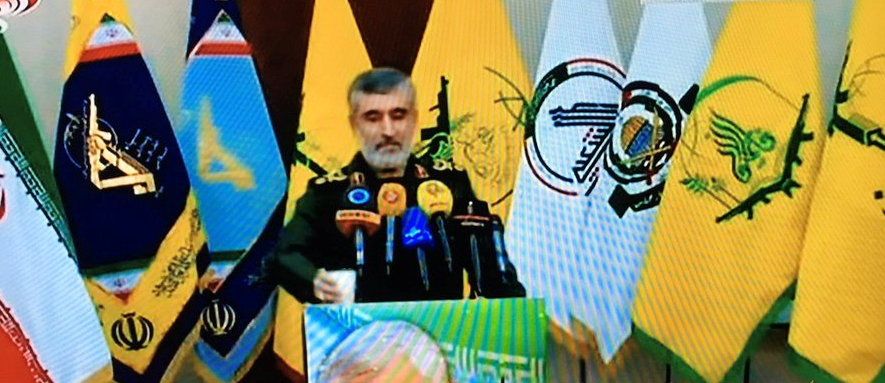
This was the first occasion in which an IRGC commander gave a speech with the flags of the so-called components of the Axis of Resistance in the background. In the past, IRGC commanders always spoke with the flags of the IRGC and Iran behind them. This is an indication that these militias are Iranian ones, not Yemeni, Syrian, Lebanese or Iraqi ones. Therefore, how did the PMF become an affiliate of the Iraqi army and its political arm has lawmakers and ministers in the Iraqi cabinet while it is an Iranian militia? Does it work for the sake of Iraq or Iran? How come Hezbollah has parliamentarians and cabinet members while it is working for the sake of Iran? What about the Hamas movement, which considers itself a resistance movement, not an Iranian proxy?
By doing so, Iran wants to send a message to both the domestic front and the outside world, reiterating its expansionist agenda and announcing that it is the main partner in taking and making decisions in these countries and that its role is far beyond the reports of offering merely financial, political and military support. It revealed the true role of these militias as they work for Iran, not for their homelands where they settle. From another perspective, such a move will bring more harm to Iran than any benefit. Any act that will be carried out by these militias will be blamed directly on Iran as it has admitted these militias are its proxies. It is also expected that all these militias will be classified as terrorist organizations as they are Iranian militias who are carrying out acts beyond Iranian borders.
Conclusion
Although Iranian and US remarks point to the fact that military escalation on the Iraqi scene is over and that the two parties do not have a desire to engage in armed confrontation which would result in disastrous implications for all concerned parties in the region and they intend to move to the period before the killing of a US local contractor, and severe US sanctions shall continue to be in place despite the fact that Iran continues to refuse to engage in negotiations without the lifting of the sanctions, the possibility of a renewed escalation between the US and Iran remains likely at any moment. This is because of not addressing the roots of the US-Iranian conflict, which include amending the nuclear deal, curbing Iran’s ballistic missiles program, reducing Iranian regional clout and the desire of Iranian militias to respond by targeting US forces.
Iran here shall emerge as a loser on all measures. Iran, represented by its regional proxies, did not make any strategic gains by stepping up attacks on US forces in Iraq, except the strikes against Iraqi popular protests, which oppose Iranian influence in Iraq and demand Iraq returns to the Arab sphere as Iran exceeded US redlines. This threw the region into a limbo of whose disastrous implications regional countries have long been warning of. An armed confrontation will not serve the interests of anybody while sitting down around the negotiating table is the most favorable option in order to achieve Iranian strategic objectives in a diplomatic way, which comes as President Donald Trump said that Iran will never win a war, but it had never lost a negotiation.
Even attempts to use the killing of Soleimani to win more popular support, public approval and public mobilization behind the regime have failed. The regime lost the public sympathy it gained following the death of Soleimani after its admission that it was behind the downing of the Ukrainian plane which had 176 passengers onboard. The victims included 82 Iranians, 63 Canadians, 11 Ukrainians, nine crewmembers, 10 Sweden nationals, 3 Afghans, 3 Britons and 3 from Germany, according to the Ukrainian Foreign Minister Vadym Prystaiko. The plane was hit by a missile minutes after taking off from Khomeini Airport. In the aftermath of the disaster, popular protests involving students, took to the streets and demanded the resignation of the supreme leader, and the IRGC’s control over the country to end. They chanted the slogan ‘Death to the Dictator’ in reference to Khamenei and “Khamenei is a killer […]His rule is null and void.”
